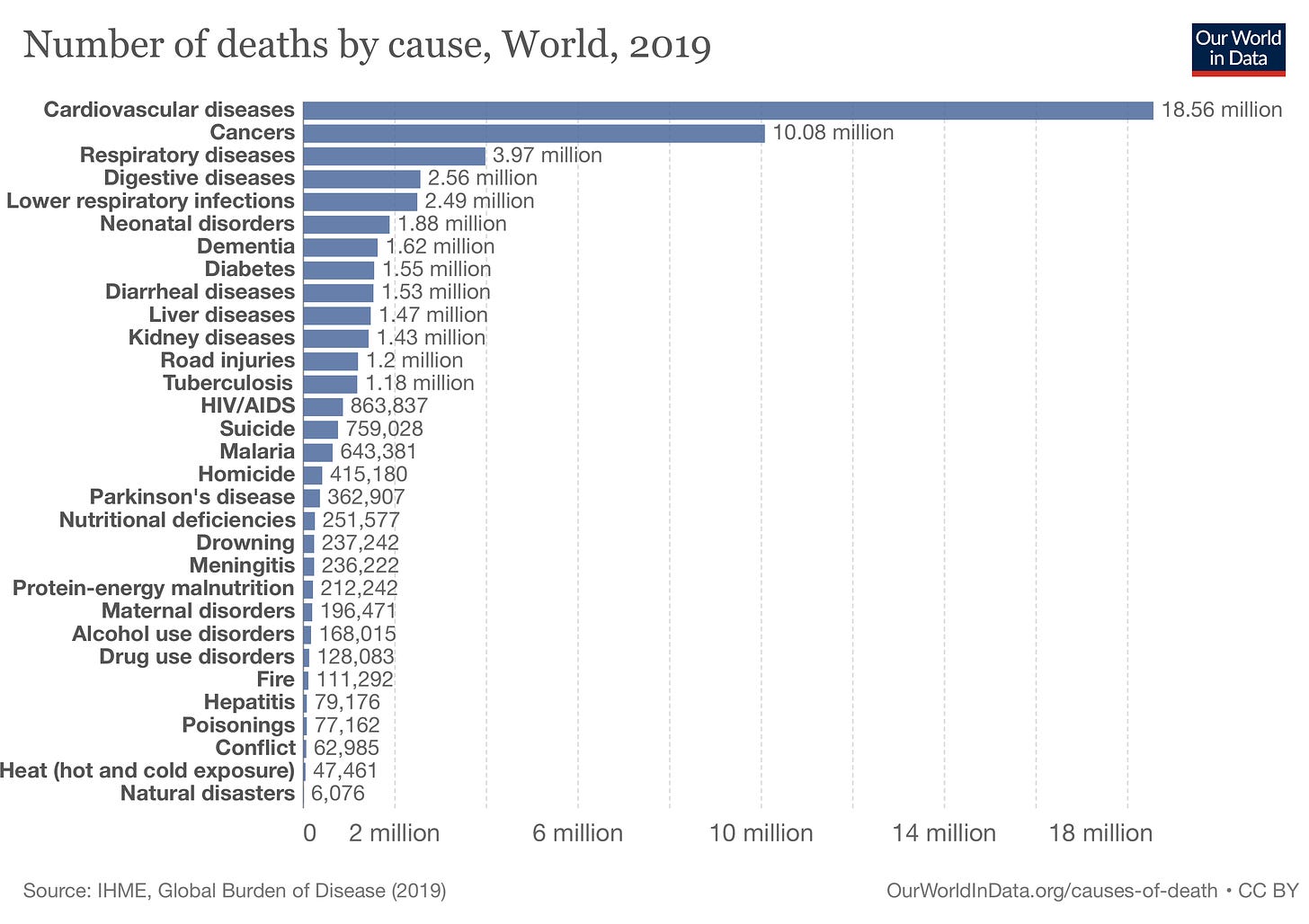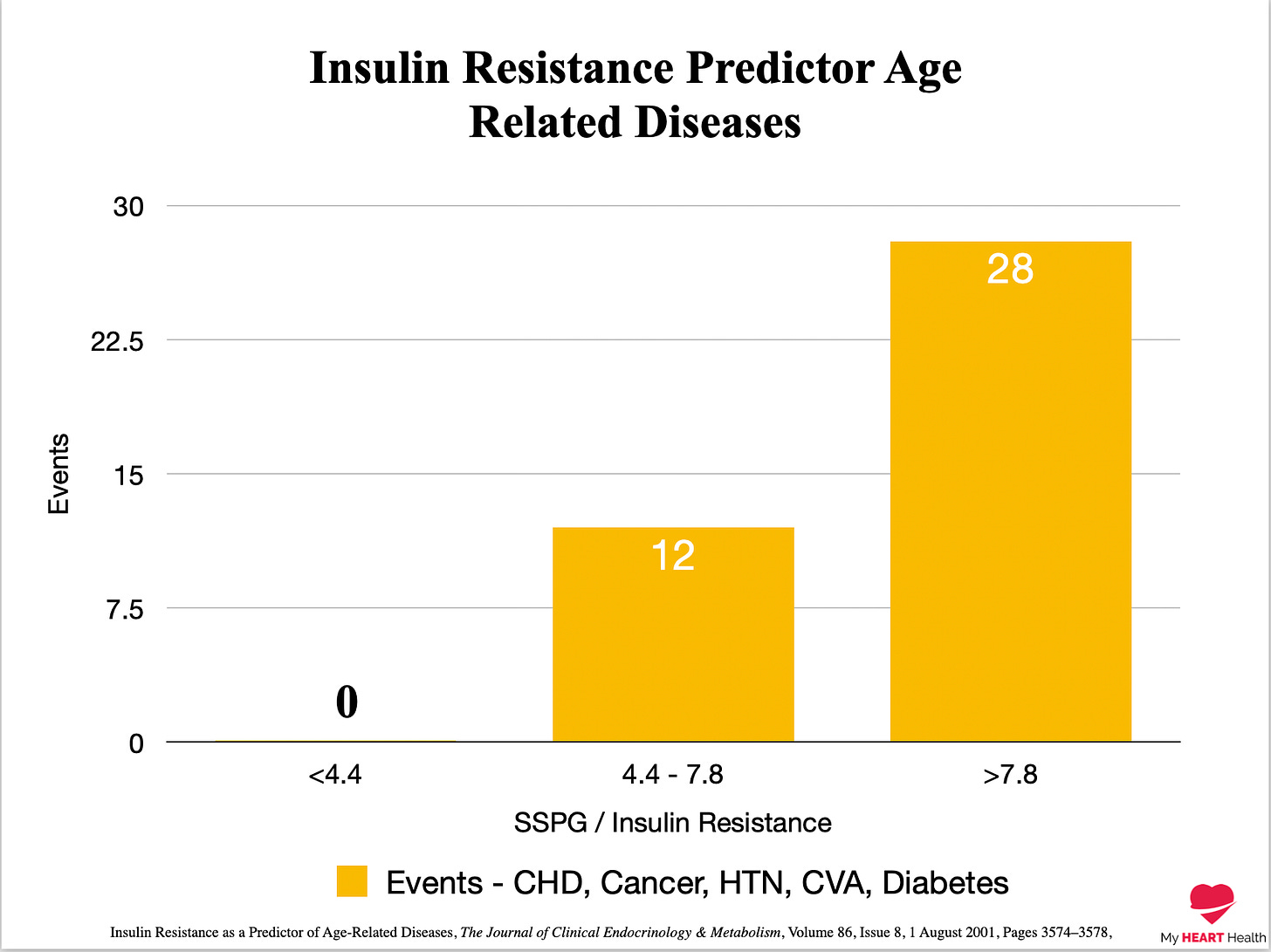Insulin Resistance: The Key To Chronic Disease
Why insulin resistance may the key risk factor for the diseases most likely to kill you
You are going to die from something.
The key to living longer is to delay the onset of the disease that is likely to kill you1.
The leading causes of death worldwide are cardiovascular disease and cancer. They are the leading causes by a very large margin2.
The priority then is to delay the ONSET of cardiovascular disease or cancer to later in life.
This is done by preventing or managing the risk factors that lead to these diseases.
The leading risk factors for adults over 50 years of age are clear3.
High blood pressure
Smoking
Pre-diabetes/Diabetes
Overweight/Obesity
Smoking is an obvious risk factor for cardiovascular disease and cancer that requires no further explanation.
But let’s look at the other three factors.
Does this cluster of risk factors remind you of anything?
Answer: Metabolic Syndrome.
(Tweet Thread below on metabolic syndrome if you need a refresher)

Having metabolic syndrome significantly increases your risk of heart disease and certain cancers45. This is why this cluster of risk factors is the leading set of risk factors for early death.
But what causes metabolic syndrome?
In short, insulin resistance6.
So what is insulin resistance?
Insulin is a hormone released from your pancreas to move glucose from your bloodstream into your liver, muscle and fat cells to store it as glycogen.
Insulin resistance is when you need more insulin than normal to do the above task7.
The end result is higher levels of circulating insulin.
For the most part, high insulin levels do not cause any symptoms and are usually elevated for years, possibly decades, before the appearance of any medical conditions or blood tests that are usually done.
Insulin resistance is present for 10 to 15 years before the appearance of type 2 diabetes8.
This bears emphasising:
For these 10 to 15 years, a person’s glucose will be entirely normal.
There will be NO signs of any issue on traditional blood glucose or HBA1c blood tests.
Of all the silent killers.
This is the one to pay the most attention to.
Insulin levels can be measured with a simple blood test. The challenge is it is rarely done.
Cardiovascular Disease
High cholesterol causes coronary artery disease.
But if cholesterol is the fire that causes coronary artery disease, insulin resistance is the equivalent of throwing gasoline on that fire.
Compared to those with low insulin levels (No insulin resistance) and low cholesterol levels as measured by APOB (The best measure of cholesterol), those with both high insulin and high cholesterol/APOB had a risk of heart disease that was 11 times higher9.
High Cholesterol + High Insulin = Very Bad News
But to dispel any doubt, if you had normal insulin levels and high cholesterol, your risk was still 80% higher than if you had both normal insulin and cholesterol.
Cholesterol in the presence of high insulin levels leads to the formation of small dense cholesterol particles that are more likely to cross the artery wall and cause atherosclerosis to form.
Remember, type 2 diabetes is a state of very high insulin levels, which is why it is a risk factor for coronary artery disease, with the risk being ten times that of someone without diabetes10.
Diseases Of Ageing
Conditions such as cancer, high blood pressure, diabetes and heart disease are often thought of as predictable ‘diseases of ageing’.
But maybe they are simply diseases of insulin resistance?
Worsening insulin resistance is associated with a higher risk of cancer, heart disease, high blood pressure and stroke11.
Studies have shown that in healthy non-obese individuals followed from age 50, those with high insulin levels at baseline were most likely to be diagnosed with any of the above conditions mentioned.
Interestingly, the individuals with low insulin levels at baseline were not diagnosed with any of the above conditions over the approximately ten years of observation.
To be clear. Normal insulin levels are likely to be very protective against the premature onset of these conditions, but in isolation is not going to provide complete immunity from them.
Reversing Insulin Resistance
While the outlook for those with insulin resistance appears bleak, the amazing news is that high insulin levels and insulin resistance can be reversed.
The solution?
You guessed it.
Exercise.
There are specific types of exercise that are likely to be far more effective at addressing insulin resistance, but even a single bout of exercise can improve insulin sensitivity by up to 40%12.
This is likely why regular exercise is associated with a reduced likelihood of prematurely dying from ANY cause13.
Reversing insulin resistance is also associated with weight loss, and the optimal approach is to combine the two strategies1415.
When it comes to delaying the onset of the chronic diseases that are most likely to kill you, insulin resistance is likely underlying most of them.
To be 100% clear, insulin resistance is likely not the CAUSAL factor for all of the conditions mentioned, but it is very likely to be a major accelerant.
If extending your life is a priority, then understanding if you have insulin resistance is a must.
If you have insulin resistance, and even if you don’t, exercise has to be a daily part of your life.
Measuring blood insulin levels can be a challenge but ask yourself if, from what you have read above whether overcoming that challenge is worth it.
I think it is.
The data makes it 100% clear that it is.
Health span approximates life span among many supercentenarians: compression of morbidity at the approximate limit of life span. J Gerontol A Biol Sci Med Sci. 2012 Apr;67(4):395-405.
https://ourworldindata.org/causes-of-death
Global burden of 87 risk factors in 204 countries and territories, 1990–2019: a systematic analysis for the Global Burden of Disease Study 2019. Lancet 2020;396: 1135–59
Impact of the metabolic syndrome on mortality from coronary heart disease, cardiovascular disease, and all causes in United States adults. Circulation. 2004 Sep 7;110(10):1245-50.
Metabolic syndrome is a risk factor for cancer mortality in the general Japanese population: the Jichi Medical School Cohort Study.Diabetol Metab Syndr 11, 3 (2019).
Insulin resistance as the underlying cause for the metabolic syndrome. Med Clin North Am. 2007 Nov;91(6):1063-77, viii.
https://www.niddk.nih.gov/health-information/diabetes/overview/what-is-diabetes/prediabetes-insulin-resistance
Insulin Resistance. [Updated 2022 Jul 4]. In: StatPearls [Internet]. Treasure Island (FL): StatPearls Publishing; 2022 Jan-. Available from: https://www.ncbi.nlm.nih.gov/books/NBK507839/
Hyperinsulinemia as an Independent Risk Factor for Ischemic Heart Disease. N Engl J Med 1996; 334:952-958
Association of lipid, inflammatory, and metabolic biomarkers with age at onset for incident coronary heart disease in women. JAMA Cardiol 2021;6:437–47
Insulin Resistance as a Predictor of Age-Related Diseases, The Journal of Clinical Endocrinology & Metabolism, Volume 86, Issue 8, 1 August 2001, Pages 3574–3578,
Ross R. Does Exercise Without Weight Loss Improve Insulin Sensitivity. Diabetes Care. 2003; 26(3): 944-45.
Cardiorespiratory Fitness and Mortality Risk Across the Spectra of Age, Race, and Sex. J Am Coll Cardiol. 2022 Aug 9;80(6):598-609.
Individual Response Variation in the Effects of Weight Loss and Exercise on Insulin Sensitivity and Cardiometabolic Risk in Older Adults. Front Endocrinol (Lausanne). 2020 Sep 10;11:632.
Reversal of muscle insulin resistance by weight reduction in young, lean, insulin-resistant offspring of parents with type 2 diabetes. Proc Natl Acad Sci U S A. 2012 May 22;109(21):8236-40.







Hi Paddy, great read , but can an overhaul of diet for example keto/ paleo etc not have a very positive and in some cases reversing effect in insulin resistance and type 2 diabetes. The research seems to show this and along with good quality exercise you can reduce another major risk factors like weight and blood pressure .
Play golf with a few cardiologists they are all on statins
What’s your opinion